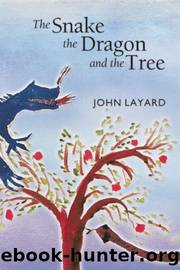The Snake, The Dragon and The Tree by Layard John

Author:Layard, John [Layard, John]
Language: eng
Format: epub
Publisher: July, 2009
Published: 2010-11-17T16:00:00+00:00
Figure 21. The resurrected Christ, or Christ inter- nalised. “Noli me tangere”, Duccio di Buoninsegna, Cathedral, Siena. New York, Art Resource
We may be helped to understand her problem if we compare this painting with Figure 21 of the woman worshipping the figure of the Saviour, which also has two trees in it [Mary Magdalene and the risen Christ in the Garden of Gethsemane]. The Saviour holding up the cross indicates sacrifice—withdrawing of projections—and so internalising the power that had previously been externalised.
Black symbolises among other things “the unknown”. This might have been most frightening but for the redirection inwardly of her own warm emotions (indicated by the red markings) onto that psychic function in her which the snake symbolised. This was the reason why she could overcome her fears and yield to a feeling of delight, in its turn becoming adoration. That he “swayed” meant that he had life in him, and at the same time some power of reflection, not “pouncing” as her schizoid dragons, but in fact “thinking” reflectively and gently, and (still more important) subtly and flexibly. There are many instances of this swaying movement—both of trees and of snakes—in mythology indicating a many-sided flexibility. We should not forget that the serpent in Genesis was also “more subtil than any beast of the field”. This painting may therefore be related to such archetypal images, indicating a confrontation of the female dream-ego with the psychic male element, the snake.
The fact that there are also two trees shows how Mary’s life is now getting “doubled”. For the load of misery that her life has been to her till now has been due to the lack of differentiation between the two parental trees—now separated out, the one associated with the woman (herself), the other with the black snake (the father principle). This lack in the past had maintained a state of unconscious conflict in which each side was exhausted, clinched in a dark embrace, while conscious living, thinking and feeling were thus drained of their potential energy. What is depicted in the present painting is on the contrary one of the first instances in Mary’s dream-life of a new and positive form of “confrontation with the unconscious”, which is found to be so much less horrifying once it is embarked on than is the fear of it when it is not. We have seen its former refusal in Painting 10, which the transference has now reversed.
This dream is in strong contrast with many of Mary’s earlier dreams and fantasies which have not been included here. In these she had encountered what appeared to her as “a priest” or “monk” or “nuns” in woods or in some splendid temple. She had these dreams when she herself had the feeling of “not belonging” and so of being lost or in despair. It was as though everyone else in the world had value but she had none, and they knew something which she did not know and that she never would. In waking life she did not ultimately believe this, but often thought she “should”.
Download
This site does not store any files on its server. We only index and link to content provided by other sites. Please contact the content providers to delete copyright contents if any and email us, we'll remove relevant links or contents immediately.
Rewire Your Anxious Brain by Catherine M. Pittman(18229)
Talking to Strangers by Malcolm Gladwell(12826)
The Art of Thinking Clearly by Rolf Dobelli(9847)
Mindhunter: Inside the FBI's Elite Serial Crime Unit by John E. Douglas & Mark Olshaker(8667)
Becoming Supernatural by Dr. Joe Dispenza(7809)
Change Your Questions, Change Your Life by Marilee Adams(7342)
The Road Less Traveled by M. Scott Peck(7255)
Nudge - Improving Decisions about Health, Wealth, and Happiness by Thaler Sunstein(7215)
The Lost Art of Listening by Michael P. Nichols(7138)
Mastermind: How to Think Like Sherlock Holmes by Maria Konnikova(6910)
Enlightenment Now: The Case for Reason, Science, Humanism, and Progress by Steven Pinker(6854)
Win Bigly by Scott Adams(6801)
The Way of Zen by Alan W. Watts(6266)
Daring Greatly by Brene Brown(6206)
Big Magic: Creative Living Beyond Fear by Elizabeth Gilbert(5321)
Grit by Angela Duckworth(5277)
Men In Love by Nancy Friday(4947)
Ego Is the Enemy by Ryan Holiday(4919)
Altered Sensations by David Pantalony(4845)
